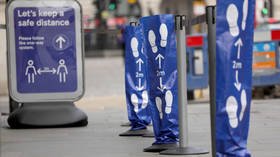Tired of social distancing? Experts warn we could be stuck with it for TWO YEARS

Extreme measures to tackle the coronavirus pandemic have many people questioning how long lockdown will last. Now, a new study estimates that social distancing efforts will need to continue in some form for a year – or more.
Toronto-based public health researchers modeled Covid-19 transmission in Ontario to determine which measures would help flatten the curve of the virus’ spread. The key focus of their study was preventing the healthcare system from becoming overwhelmed by an escalating influx of coronavirus patients, while also enabling a relative return to normal life.
Their results, published in the Canadian Medical Association Journal, outlined a number of scenarios, including one in which more than half of the population would become infected, resulting in 107,000 hospital admissions and 55,000 cases in intensive care units.
Also on rt.com Daleks, drones, and high-tech cops: Robots come out on top amid coronavirus pandemicFixed-duration interventions, in which physical distancing is enforced for 12 to 18 months, would likely reduce the rate of infection – but, crucially, that would also depend on how stringently people followed the rules.
According to the study, raising and lowering physical distancing orders while monitoring hospital capacity “represents a more effective, and likely more palatable, control strategy” for limiting the impact of the virus. This would mean that such rules would become more relaxed and then reinstated throughout a new wave of infections over the course of two years.
“Physical distancing and other public health measures can reduce Covid-19 spread, but once these measures are lifted, we're at risk of an uptick in cases,” the study’s lead author Ashleigh Tuite said in a statement.
Dynamic response measures that can be turned up and down in response to where we are on the epidemic curve provide a way to curb transmission while also providing periodic breaks and a chance to return to a more normal life.
The study uses the term “physical distancing,” as opposed to the more popular ‘social’ term, likely due to the recent push by health experts to emphasize the whole point is to minimize close in-person contact rather than sever social bonds.
Over 1.5 million cases of Covid-19 have been confirmed worldwide, with almost 90,000 fatalities. Around one-third of the global population is under some kind of lockdown because of the pandemic.
Also on rt.com US Covid-19 cases now account for almost ONE THIRD of global totalThink your friends would be interested? Share this story!












